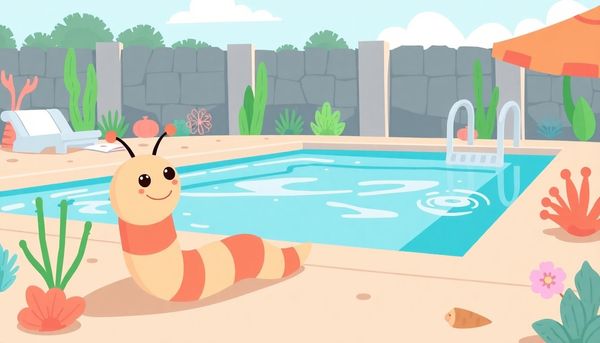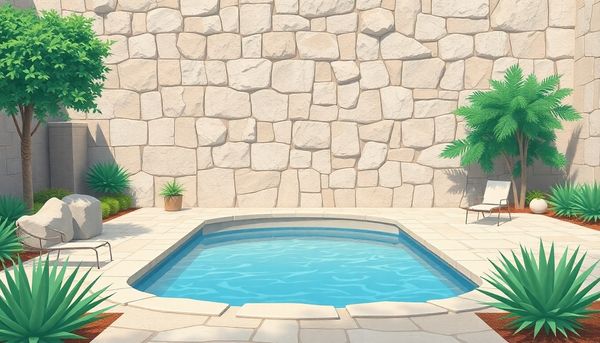Keep Your Pool Worm-Free: Effective Strategies for a Pristine Oasis
September 20th, 2024
September 20th, 2024
Gazing out at your backyard oasis, the last thing you want is an invasion of unwelcome wrigglers disrupting your serene poolside retreat. Yet, there they are—tiny intruders making waves in your otherwise pristine paradise. The presence of worms in your pool can be both perplexing and frustrating, transforming your sparkling waters into a less-than-inviting habitat. Once, I found myself in a similar predicament after a particularly stormy night. Waking up to find a small army of worms lining the edges of my pool was not the morning surprise I had anticipated.
Why do these earthbound creatures find their way into your pool? More often than not, it's a combination of heavy rainfall and the natural environment around your home. As the rain saturates the soil, worms seek refuge, inadvertently slipping into the watery depths of your pool. Unfortunately, they lack the ability to escape this unintended aquatic adventure, leaving you with the task of eviction.
In this guide, we’ll explore practical and effective methods to reclaim your pool, keeping it a clean and worm-free zone. From preventative measures to quick-fix solutions, there’s a wealth of strategies to ensure your pool remains an inviting spot for relaxation, not a wormy wonderland. Whether you're a seasoned pool owner or just dipping your toes into maintenance, these tips will help maintain the clarity and charm of your backyard haven.

Have you ever considered the unsung hero of pool maintenance—the solar pool cover? While these covers might seem like an extra chore, they work wonders against unwanted worm invasions. Imagine a blanket that keeps your pool warm while also acting as a barrier against those slimy intruders. Not only do they help maintain a desirable pool temperature by elevating it by up to 15 degrees, but they also significantly curb water evaporation, saving both your pool chemistry and sanity.
You might be wondering about the hassle. Indeed, removing and deploying a solar cover can be cumbersome, especially during those spontaneous pool days. However, timing can be everything. Consider placing the cover during vulnerable periods—cooler nights or when heavy rain is on the horizon. This proactive step ensures that when the worms emerge, they find a blockade rather than a watery demise.
A personal tip: invest in a cover that’s user-friendly. Some designs are incredibly intuitive, making the process less of a chore. As an added bonus, these covers often come with warranties, giving you peace of mind and added value. By implementing a solar pool cover, you're not just keeping worms at bay; you're making an eco-friendly choice that preserves your pool’s beauty and your leisure time.
Few things can ruin a perfect pool moment like the unexpected company of worms. While they're great for gardens, they’re less welcome in your backyard oasis. Enter solar pool covers—a nifty shield against these uninvited guests. A friend of mine discovered this handy tool last summer. Her pool, nestled amid lush landscaping, often attracted worms, especially after rain showers. Tired of the constant cleanup, she decided to try a solar cover.
Unlike traditional pool covers, solar covers not only keep worms out but also offer additional benefits. They help heat your pool by up to 15 degrees, making that evening swim even more inviting. Plus, they drastically cut down water and chemical evaporation, which is great for both the environment and your wallet. While it’s true they can be a bit cumbersome to maneuver, especially if you’re in a hurry, there are now options designed for easier handling.
During wetter seasons or unpredictable weather, covering your pool becomes even more crucial. Although it's not an everyday solution, in conjunction with regular pool maintenance, a solar cover can significantly minimize worm invasions. So, next time you’re bracing for a storm, consider slipping on that solar cover. Not only will you keep your water worm-free, but you'll also be investing in a more sustainable pool experience.
There's a twist to the battle against pool-invading worms: the deck design. A thoughtfully crafted pool deck can be your first line of defense. While worms may not be the brightest navigators, altering their path can significantly reduce their accidental swim.
Consider elevating your deck slightly above the surrounding area. Raising the pool deck creates a mild barrier that worms find tricky to cross. While it won’t turn your pool into a fortress, it nudges nature in your favor, making it less likely for these critters to find their way into the water. I remember when my uncle decided to refurbish his pool deck; the small incline he added not only enhanced the aesthetics but also noticeably reduced worm visits.
Another clever hack involves strategic landscaping. By placing a gravel or stone buffer zone around the pool, you create a less hospitable environment for worms. They prefer soft soil, so a gravel border can divert their journey elsewhere. However, ensure the gravel doesn’t affect your pool’s water chemistry, especially during heavy rains.
For a creative touch and added deterrence, try installing strip lighting along the deck's edge. Bright lights can disorient worms, sending them looking for darker, quieter places. This subtle yet effective measure not only keeps worms at bay but also adds an inviting glow to evening swims.
Rethinking deck design, with these adjustments, can transform it from a decorative feature into a functional barrier against unwelcome pool guests.
Limestone, often hailed for its versatility, might just be the unsung hero in your battle against pool-invading worms. Nestled around the pool’s perimeter, limestone creates a natural barrier that few worms dare to cross. When I first heard about this trick, I was skeptical. Could a simple rock really keep those pesky critters at bay? Spoiler alert: it works, and here's how.
Crushed limestone, when strategically placed, elevates the soil's pH level. Worms, sensitive to these changes, find the altered environment less hospitable and tend to steer clear. By sprinkling limestone around the pool area, you’re effectively creating a no-worm zone. A friend of mine tried this after a particularly rainy season and saw a noticeable decrease in pool-bound worms. The best part? It’s a non-toxic solution, sparing your garden from chemical interventions.
However, it’s crucial to consider the weather. Heavy rain can wash away limestone, potentially affecting your pool’s water chemistry. Imagine my surprise when I discovered traces of it in my filter after a downpour! Regular water testing becomes essential to ensure everything stays balanced. Despite these considerations, limestone offers a natural and effective strategy to reduce the wriggly invaders. So next time you’re at the garden store, think about picking up a bag of crushed limestone. It might just be the ally your pool needs.

Imagine walking around your pool deck, and instead of worrying about slippery surprises, you’re greeted by a neat, worm-free space. Elevating your pool deck might just be the unsung hero in battling those wiggly intruders. By slightly raising the level of your pool deck, you create a minor yet effective barrier against worms. This elevation acts as a gentle slope, making it less appealing and more challenging for worms to navigate their way into your water oasis.
During my own backyard redesign, I noticed that simply raising the deck by a few inches resulted in fewer unwanted guests. While it’s not an absolute fix, the effort can significantly reduce the number of worms attempting to breach your pool’s perimeter. And if you’re considering a deck renovation or plan to build a new one, this could be an excellent opportunity to incorporate a strategic elevation.
You might wonder if this small change is worth the effort. The answer lies in the results: fewer worm retrieval missions and a cleaner, more inviting pool area. Paired with other worm-repelling strategies, such as crushed limestone or strategic landscaping, the elevated deck can become a cornerstone of your worm defense arsenal. So, while it may require some initial planning and effort, the long-term rewards of a worm-free pool experience are well worth the pursuit.
Unveiling a clever strategy to keep those slimy intruders at bay, solar pool covers serve as both a shield and a nifty tool for pool maintenance. These covers, with their dual purpose, not only help in minimizing worm invasions but also offer the added benefit of warming your pool. While not the most glamourous task to roll on and off, employing a solar pool cover during cooler spells or before anticipated downpours can keep your pool worm-free and shimmering.
Consider this: the sun’s rays, magnified by the cover, can raise the water temperature by up to 15 degrees, making each swim more pleasant. But that's not all. By reducing water evaporation, the cover conserves both water and chemicals—an environmentally friendly approach that saves time and money. Talk about a win-win!
For those who dread the thought of complicated setups, fear not. Modern solar covers are designed for ease, so look for those with user-friendly designs that simplify the covering process. A quick roll on when the weather hints at rain, and back off when the skies clear, can become part of your routine. Plus, many solar covers come with multi-year warranties, ensuring that your investment is protected.
While it might seem a tad inconvenient at first, this extra layer of protection can significantly cut down on worm encounters and keep your pool inviting all season long.
Walking barefoot on a warm pool deck should be a delightful experience, not a squishy encounter with unexpected visitors. One effective way to keep those wriggly guests at bay is by altering the landscape of your pool's perimeter. Think of it as a mini makeover for your pool area. By slightly elevating the pool deck, you create a gentle incline that poses a formidable challenge for our invertebrate friends from making their way into the water.
Consider this: the natural gradient acts as a deterrent, making it harder for worms to crawl their way across. Even a few inches of raised concrete can significantly reduce the number of would-be swimmers. Of course, some determined earthworms might still attempt the climb, but many will turn back or dry out before reaching the edge. In addition to height, adding a decorative border of crushed rock or gravel can further discourage their advance.
For a more natural barrier, crushed limestone sprinkled along the deck's edges can serve a dual purpose. Not only does it elevate the soil's pH level, which worms find unappealing, but it also lends an aesthetically pleasing look to your poolside oasis. Just keep an eye out for heavy rains, as they might carry limestone into your pool, affecting water chemistry. Regular water testing will ensure everything stays balanced and beautiful.
Ultimately, these structural tweaks transform not just the look of your pool but also its worm-friendliness, turning a potential breeding ground into a peaceful retreat. With thoughtful modifications, you can keep your pool deck pristine and worm-free, enriching your swimming experience with each dive.
The allure of a beautifully landscaped poolside is undeniable—but it's also a secret invitation for worms to join the party. To strike a balance between aesthetics and functionality, a few strategic landscaping adjustments can help keep these uninvited guests at bay.
Consider starting with a good look at the distance between your pool and its surrounding greenery. By increasing this gap to around 20 feet, you create a buffer zone that discourages worms from making a beeline to the water. The extra ground they have to cover makes it less likely they’ll reach your pool before the sun sends them scurrying back to safety.
An intriguing tactic involves altering the edge of your pool deck. If your deck meets the soil or grass seamlessly, raising the deck slightly could serve as a subtle barrier. This elevation doesn't have to be dramatic; even a small incline can deter worms, making their journey just a bit too arduous. While it won't eliminate the problem entirely, it certainly reduces the numbers you'll need to skim out.
And then there's the pH play. A border of crushed limestone along your pool’s perimeter can shift the soil's pH, turning it into a less-than-ideal environment for worms. Caution is key, though—rain can wash limestone into the pool, impacting water chemistry. Regular water testing is essential if you opt for this method.
With these landscaping tweaks, you're not just beautifying your space; you're quietly telling those pesky worms to keep their visits brief and infrequent.

Have you ever noticed how your yard’s layout can influence the unexpected presence of worms in your pool? The relationship between landscaping and those slippery intruders is more intertwined than you might think. When your flower beds or lush green patches are sprawled too close to your pool, you're essentially rolling out the red carpet for worms to take a leisurely stroll—or slither—into your aquatic oasis. To combat this, consider relocating your garden beds or any soil-heavy landscapes at least 20 feet away from the pool perimeter.
In my own backyard adventure, I learned the hard way that a well-placed patch of marigolds wasn’t just attracting bees. After relocating these bright blooms further from the pool, I noticed a significant drop in worm sightings. It's a straightforward solution: by increasing the distance, you give worms a longer journey to tackle, increasing the likelihood they'll turn back or dry out under the sun before reaching the pool deck.
Additionally, tweaking the design of your poolside area can be beneficial. If your pool’s deck is flush with your garden, try elevating the concrete slightly. This minor adjustment can discourage worms, which aren't exactly natural rock climbers. And for an extra layer of deterrence, sprinkle some crushed limestone along the boundary—it’s a natural, albeit temporary, way to nudge worms in the opposite direction. These subtle changes can make a world of difference, turning your pool into a worm-free zone while keeping your garden vibrant and thriving.
Tackling the persistent problem of worms in your pool often begins with a few strategic tweaks to your pool deck. First, consider altering the incline of your deck. A slight elevation can deter worms from making their way into the water, as they find it challenging to navigate even modest slopes. I remember my neighbor, Mark, who noticed a significant decrease in pool intruders after raising his deck by a couple of inches. It wasn't a complete fix, but it certainly helped reduce his skimming chores.
In addition, think about the materials and textures around your pool area. Incorporating materials such as crushed limestone along the perimeter can serve as a natural barrier. Worms dislike the higher pH levels, and thus, tend to steer clear of it. My cousin tried this method and found that, though not foolproof, it did significantly cut down on the worm population. However, keep in mind that heavy rainfall can wash limestone into your pool, potentially impacting water chemistry, so monitoring is essential.
Finally, regular maintenance plays a crucial role. After a storm, take a few minutes to inspect and clean your deck, removing any wayward worms before they tumble in. This simple act can prevent many from meeting their watery fate. Implementing these minor adjustments can make a world of difference, transforming your pool experience from a worm-infested wade to a serene swim.
Among the array of strategies to combat the unwelcome presence of worms in your pool, solar pool covers stand out as a practical solution with added perks. Trust me, these covers might just become your best friend during the wetter seasons. Not only do they block those curious worms from slipping into your pool, but they also offer the bonus of warming the water naturally. Imagine extending your swimming season by a few weeks thanks to a cover that retains heat while keeping the creepy crawlies away.
Now, I understand the reluctance that might accompany the task of rolling out and reeling in these covers. It's not exactly the most glamorous chore, is it? Yet, timing is crucial. Consider using the cover primarily during cooler months or when the forecast predicts rain. This way, you're not constantly battling with it, but strategically employing it when worm activity is likely to spike.
There's a variety of options in the market, so look for covers that boast easy handling features. Personal favorites are those with built-in reels or lightweight materials that allow for swift covering and uncovering. They even save on water and chemical costs by reducing evaporation. Plus, with many offering long-term warranties, they’re a worthy investment not only for your pool's cleanliness but also for its longevity.
While no single method will solve the worm dilemma entirely, integrating a solar cover into your pool care routine can significantly cut down on the squirm factor, keeping your water inviting and worm-free.
Even the most pristine pools can be frequented by uninvited guests, and crushed-limestone barriers offer a clever way to deter these slimy intrusions. When worms decide to embark on their misguided journeys towards your pool, a simple yet effective line of defense can be just the trick to keep them at bay. By placing crushed limestone around the perimeter of your pool deck, you create a natural barrier that worms find far from inviting.
Worms, naturally averse to high pH levels, will think twice before crossing over this unfamiliar terrain. The limestone alters the acidity of the surrounding soil, encouraging worms to head in the opposite direction. This approach is not only effective but also blends seamlessly into your landscaping, giving your pool area a neat and tidy look.
However, a word of caution: limestone has its quirks. During heavy rains, there's a risk it might wash into your pool, potentially disrupting the delicate balance of your pool’s water chemistry. To mitigate this, ensure you regularly monitor your pool's pH and alkalinity levels, particularly after a downpour. This proactive step will keep your water sparkling and your filter free from unwanted limestone deposits.
Incorporating crushed limestone is a savvy strategy for those battling worm invasions. It requires minimal maintenance but delivers maximum peace of mind, allowing you to enjoy a worm-free swim every time you plunge into your pool.

A lesser-known yet effective strategy involves the use of crushed limestone. This simple addition can act as an unassuming guardian, deterring worms from venturing too close to the water. Crushed limestone, when sprinkled around the perimeter of your pool, alters the pH of the surrounding soil. Worms, surprisingly particular about their environment, find this new terrain far less hospitable. As a result, they often change direction, steering clear of your pool’s edge.
This method is not without its nuances. The presence of heavy rain can sometimes wash the limestone into your pool, disrupting water chemistry and potentially clogging filters. It’s akin to a balance act; while you’re keeping worms at bay, you must also keep an eye on your pool’s pH levels. Regular water testing becomes crucial to ensure that the pool remains safe and inviting for swimmers.
A friend of mine swears by this technique, claiming it saved countless hours previously spent fishing worms out of the skimmer. But, like any pool maintenance trick, it requires diligence. If you decide to give crushed limestone a try, remember to stay vigilant about the weather and your pool’s chemical balance. It might just become another tool in your arsenal against those pesky intruders.
You’ve just finished skimming a rogue worm from your pool, and now you’re eyeing those landscaped borders around your oasis. Here's where the magic of landscape modification comes into play. By thoughtfully altering your poolside environment, you can reduce the number of uninvited guests. Start by examining the transition between your pool deck and your garden. Often, worms meet their watery fate because the lush, worm-friendly environment is too close to the pool's edge. Create a buffer zone by relocating garden beds and plantings at least 20 feet from the pool.
Consider the design of your pool deck, too. Elevating the concrete slightly above the surrounding terrain forms a natural barrier, deterring worms from their accidental plunge. Even a small incline can make a world of difference, redirecting their path and reducing their number in your pool.
Another trick involves the soil itself. Introducing crushed limestone around the perimeter of your pool can make the surrounding earth less inviting to worms due to its higher pH. But tread carefully; heavy rains can wash this material into your pool, affecting water balance. Regular water testing becomes crucial in this scenario to maintain optimal pool conditions.
Through these landscape modifications, you might not bid farewell to all worms, but you'll welcome fewer of these slimy swimmers into your backyard paradise.
A sunny day beckons, and a poolside lounge whispers your name. But first, the pesky issue of worms taking a dip in your pristine waters must be addressed. Enter crushed limestone, a surprising yet effective ally in your battle against these uninvited guests. Scattering crushed limestone around your pool’s perimeter can be a game-changer. This simple barrier raises the pH level of the soil, creating an environment that worms find less than hospitable. As they venture out after a rain shower or during cooler times, they’ll instinctively steer clear of your pool, seeking more favorable ground elsewhere.
This method isn’t just effective; it's also straightforward to implement. Simply apply a thin layer of crushed limestone where your pool deck meets the earth. It acts as a gentle deterrent, redirecting the little wrigglers before they ever have a chance to slip over the edge and under the water’s surface. However, caution is key. During heavy rains, limestone can wash into the pool, potentially altering the water’s chemistry. Regular testing and balancing of your water will help prevent any unwanted surprises.
Incorporating crushed limestone into your pool maintenance routine not only saves you the hassle of scooping slithering creatures from your skimmer but also allows you to relax and enjoy your oasis without interruption. A little forethought goes a long way in maintaining a worm-free zone, turning your pool into the serene sanctuary it should be.
Swimming pools and worms are not typically the match made in heaven anyone imagines, yet there are several innovative strategies to keep these uninvited guests at bay. First, consider a natural predator approach. Certain bird species, like robins and thrushes, love snacking on worms. Creating a bird-friendly environment around your pool might naturally reduce worm numbers. Add bird feeders and birdbaths at a safe distance from the pool to attract these feathered friends without inviting them for a swim.
Another intriguing angle is the use of diatomaceous earth. This fine powder, made from the fossilized remains of tiny aquatic organisms, can be sprinkled around the pool’s perimeter. When worms slide across this barrier, the sharp particles damage their exoskeletons, causing dehydration. It's a game-changer for those looking to maintain a more eco-friendly solution. However, it’s crucial to apply it carefully and keep it away from the pool water itself.
For a tech-savvy approach, consider motion-activated sprinklers. These devices can be strategically placed around the pool area to discourage worms from venturing too close. The sudden burst of water can deter them without any chemicals involved. It’s a humane method and doubles as a deterrent for other pests.
Lastly, experiment with lighting. Worms are more active at night, so consider soft pool lighting to dissuade their nocturnal wanderings. By exploring these alternative methods, you can tackle the worm problem from multiple angles, enhancing your poolside experience without harming the ecosystem.

For those wrestling with persistent worm invasions in their pool, insecticides might seem like an option of last resort—akin to calling in the cavalry when all else fails. While it’s not the first line of defense, certain situations can warrant this drastic measure. I’ve had my fair share of battles with nature, and sometimes, nature insists on a bit more than just a nudge.
Considering insecticides involves understanding both the benefits and the drawbacks. On one hand, applying these chemicals to the grass or landscaping surrounding the pool can effectively reduce not just worms but other intrusive insects. This might be particularly useful if you’ve tried other methods like covers, elevation changes, or crushed limestone without success. Yet, there’s a flip side. Insecticides don’t discriminate; they can disrupt the ecological balance in your garden by harming beneficial insects as well, which could affect your plants' health.
Before taking this step, weigh the severity of the worm problem against the potential ecological impact. In my experience, I’ve found that sometimes a combination of preventive measures and targeted insecticide use can strike a balance—mitigating the worm issue without causing undue harm to the surrounding environment. If you choose this route, opt for products safe for poolside use and always follow the manufacturer's guidelines to minimize any adverse effects. With careful application, this can be a tool in your arsenal to maintain a serene, worm-free swim experience.
After a long day, few things are more inviting than a refreshing dip in a clear, worm-free pool. One often-overlooked yet highly effective strategy to keep those uninvited guests out is implementing solar pool covers. These covers act like guardians of your pool, creating a barrier that not only keeps the worms at bay but also harnesses the sun’s energy to warm the water beneath.
Solar covers are not just about protection; they bring a set of benefits that could make them your pool’s best friend. With the potential to raise water temperatures by up to 15 degrees Fahrenheit, these covers extend your swimming season, offering a naturally heated pool without the hefty energy bills. Furthermore, they dramatically reduce water evaporation, saving you time and money on refilling and rebalancing the pool's chemicals.
Of course, as with most things, there’s a trade-off. The task of covering and uncovering the pool can seem like a chore, especially when all you want is a quick splash. However, reserving this step for times of heavy rain or cooler temperatures can strike a balance between convenience and worm prevention. Opt for user-friendly designs that make the cover easy to manage, so you’re more likely to use it regularly.
Investing in a solar pool cover doesn’t just protect your pool from worms; it turns your swimming space into an efficient and environmentally friendly oasis. As a bonus, you'll find yourself spending more time enjoying your pool and less time dealing with unwanted slimy surprises.
The charm of a pool can swiftly diminish when wiggly guests sneak their way in, so tweaking your pool deck design might just be your secret weapon. Elevating the deck, for instance, can act as a subtle yet effective barrier. Worms, lacking the agility of more advanced creatures, find it difficult to ascend even modest inclines. By creating a slight elevation where your pool deck meets the landscape, you may reduce the number of worms inadvertently waddling into your watery retreat.
Yet, there's more to it than simply raising the ground level. Incorporating decorative edging or a shallow trench filled with materials like gravel or small stones can enhance the aesthetic while adding a physical challenge for wandering worms. This little trick not only adds a rustic charm but also dissuades our soil-loving friends from crossing over.
Speaking of aesthetics, consider planting strategically around this elevated boundary. Opt for plants that thrive in well-drained soils, as these may naturally deter worms from congregating near your pool. Such thoughtful landscaping not only beautifies your space but also works in tandem with your elevated deck design.
Incorporating these design tweaks won’t entirely banish worms, but a clever combination of elevation and thoughtful planting can make a noticeable difference. Transforming your pool area doesn’t just enhance its visual appeal; it serves as a functional line of defense against those uninvited slimy surprises.

This article provided insights into maintaining your pool. Start your pool care journey today!
Want to become a pool maintenance expert? Our free Pool School course covers everything you need to know about pool care. From basic maintenance to advanced troubleshooting, you'll learn how to:
Join over 10,000 pool owners who have already transformed their pool care routine. Get started with our free Pool School course today!